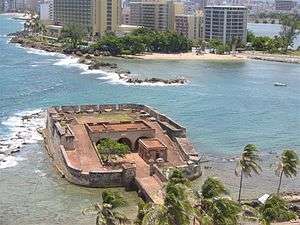Battle of San Juan (1797)
| Battle of San Juan (1797) | |||||||
|---|---|---|---|---|---|---|---|
| Part of the French Revolutionary Wars | |||||||
 The Fortín de San Gerónimo was key to the defense of San Juan. | |||||||
| |||||||
| Belligerents | |||||||
|
|
| ||||||
| Commanders and leaders | |||||||
|
|
| ||||||
| Strength | |||||||
|
Estimated 6,000-13,000 men 68 warships | 6,000- 7,000 men | ||||||
| Casualties and losses | |||||||
|
37 killed, 70 wounded, 124 captured or missing, 400 surrender[1] |
47 killed, 28 wounded, 56 captured or missing, 18 surrender | ||||||
The Battle of San Juan was a 1797 British attack on the Spanish colonial port city of San Juan in Puerto Rico. The attack was carried out facing the historic town of Miramar.
On 17 April 1797, Lieutenant-General Sir Ralph Abercromby invaded the island of Puerto Rico with a force of 6,000-13,000 men,[2] which included German soldiers and Royal Marines and a 60 to 64 ship armada.
The Spanish spotted an enemy convoy off the coastline on the morning of April 17. Upon this sighting, the Governor, Brigadier General Ramón de Castro, summoned his military Chiefs to immediately put a defense plan into action. Along strategic points throughout the coastline, garrison troops were placed into position. While attempting to maneuver ships into the inlet, the British fleet encountered a problem. There was an underwater reef that was very narrow so that only frigates and smaller transport ships could enter. The British placed two frigates at the opening of the port to deny entrance to other ships. On April 18, anchored British ships began bombarding points where the Spanish had taken defensive positions to protect the beach.
After some minor battles, the British sent a ship flying diplomatic colors to the entrance of the port and was met by an aide-de-camp who was given a message for the Commanding Officer of the city. In the message, they demanded the immediate surrender of Spanish forces. The British ship did not wait for a response, and in some confusion later in the night, a Spanish ship carrying a reply message came under fire.
Controlling the port became a chess match as the Spanish fleet mimicked every move by the British armada. The British were able to land many small groups of soldiers along the beach, some of which were German soldiers who were fighting alongside the British. During the day on April 19, two German soldiers were captured. One of the soldiers had in his possession a hand-written paper containing a name of a city resident. The Spanish, fearing a traitor in their ranks, had this man arrested.
The order was given on Friday, April 21 by the Spanish to destroy San Antonio bridge to eliminate an opportunity of the British forces to take cover and advance their position.
On Saturday April 22, the Spanish began taking up defensive positions after noticing large regiments of British flying their colours just out of range of the Spanish cannons. Trenches were dug and spiked boards were emplaced to slow the impending attack.
On Monday, April 24, Militia Sergeant Francisco Diaz was chosen to lead a party of 70 men to attack a British position. They met approximately 300 British soldiers whom they were able to force to retreat despite their superior number. The raiding party found a cannon battery and captured 14 prisoners. The British then staged a counterattack and the Spanish raiding party was forced to flee.
Fierce fighting continued for the next five days. Both sides suffered heavy losses. On Sunday, April 30 the British ceased their attack and began their retreat from San Juan.
See also
References
- Alonso, Mariá M. and Milagros Flores (1997). The Eighteenth Century Caribbean and the British Attack on Puerto Rico in 1797. San Juan: National Park Service, Department of the Interior, Publicaciones Puertorriqueñas. ISBN 9781881713203
- Marley, David (1998). Wars of the Americas: a chronology of armed conflict in the New World, 1492 to the present. ABC-CLIO. ISBN 978-0-87436-837-6
Footnotes
- ↑ Marley, p. 362
- ↑ Confirmation of troop count is unattainable, only Spanish and Puerto Rican sources are available regarding troop count.
External links
- History of the Fixed Regiment of Puerto Rico by Coronel Héctor Andrés Negroni
- Alonso, María M. "Chapter XIV - Abercromby's Siege". The Eighteenth Century Caribbean & The British Attack on Puerto Rico in 1797. Archived from the original on 30 June 2006. Retrieved July 7, 2006.